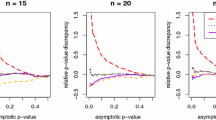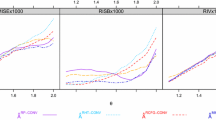Abstract
The need to incorporate the structure of complex problems in extreme value analyzes, and the requirement to exploit all the limited information that is available, has led to the increased use of advanced dependence models. When they are appropriate, these dependence models can lead to substantial benefits over simpler univariate extreme value methods. Here we explore some inference problems for the marginal and conditional distributions caused by model mis-specification. We find distinct differences in estimation characteristics when the dependence structure is asymptotically dependent or asymptotically independent, and that conditional models can be substantially improved if the variables are standardized to have common marginal distributions.
Similar content being viewed by others
References
Barão, M.I. and Tawn, J.A., “Extremal analysis of short serieswith outliers: sea-levels and athletic records,” Applied Statistics 48(4), 469–487, (1999).
Capéraà, P., Fougères, A.-L., and Genest, C., “A nonparametric estimation procedure for bivariate extreme value copulas,” Biometrika 84, 567–578, (1997).
Coles, S.G. and Tawn, J.A., “Modeling multivariate extreme events,” J.R. Statist. Soc. B 53, 377–392, (1991).
Coles, S.G. and Tawn, J.A., “Statistical methods for multivariateextremes: an application to structural design (with discussion),” Applied Statistics 43, 1–48, (1994).
de Haan, L. and Resnick, S.I., “Estimating the limit distribution of multivariate extremes,” Commun. Statist. Stoch. Models 9, 275–309, (1993).
Davison, A.C. and Smith, R.L., “Models for exceedances over high thresholds (with discussion),” J.R. Statist. Soc. B 52, 393–442, (1990).
Dekkers, A.L.M., Einmahl, J.H.J., and de Haan, L., “A moment estimator for the index of an extreme value distribution,” Ann. Statist. 17, 1833–1855, (1989).
Draisma, G., “Parametric and semi-parametric methods in extreme value theory,” Ph.D. thesis, Tinbergen Institute, (2001).
Gomes, M.I., “Penultimate behavior of the extremes,” In: Extreme Value Theory & Applications (J. Galambos, J. Lechner, and E. Simiu, eds) Kluwer, Dordrecht, 403–418, (1994).
Hall, P. and Tajvidi, N., “Distribution and dependence-function estimation for bivariate extreme-value distributions,” Bernoulli 6, 835–844, (2000).
Heffernan, J.E. and Tawn, J.A., “A conditional approach to modelling multivariate extreme values (with discussion),” to appear in J. R. Statist. Soc. B, (2003).
Henderson, R., “Modeling conditional distributions in bivariate survival,” Life-time Data Analysis 2, 241–259, (1996).
Hosking, J.R.M., Wallis, J.R., and Wood, E.F., “Estimation of the generalized extreme-value distribution by the method of probability-weighted moments,” Technometrics 27, 251–261, (1985).
Joe, H., Smith, R.L., and Weissman, I., “Bivariate threshold modelsfor extremes,” J.R. Statist. Soc. B 54, 171–183, (1992).
Joe, H., Multivariate Models and Dependence Concepts, Chapman and Hall, London, 1997.
Ledford, A.W. and Tawn, J.A., “Statistics for near independence inmultivariate extreme values,” Biometrika 83, 169–187, (1996).
Ledford, A.W. and Tawn, J.A., “Modeling dependence within joint tail regions,” J.R. Statist. Soc. B 59, 475–499, (1997).
Pickands, J., “Multivariate extreme value distributions,” Proc. 43rd Sess. Int. Statist. Inst., 859–878, (1981).
Resnick, S.I., Extreme Values, Point Processes and Regular Variation, Springer-Verlag, New York, 1987.
Shi, D., Smith, R.L., and Coles, S.G., “Joint versus marginal estimation for bivariate extremes,” Technical Report 2074. Department of Statistics, University of North Carolina, Chapel Hill, 1992.
Smith, R.L., “Approximations in extreme value theory,” Technical Report 205. Department of Statistics, University of North Carolina, Chapel Hill, 1987.
Smith, R.L., “Extreme value analysis of environmental time series: an application to trend detection in ground level ozone,” Statist. Sci. 4, 367–393, (1989).
Smith, R.L., “Multivariate threshold methods.” In: Extreme Value Theory & Applications (J. Galambos, J. Lechner, and E. Simiu, eds) Kluwer, Dordrecht, 225–248, (1994).
Smith, R.L., Tawn, J.A., and Coles, S.G., “Markov chain models forthreshold exceedances,” Biometrika 84, 249–268, (1997).
Tawn, J.A., “Bivariate extreme value theory: models and estimation,” Biometrika 75, 397–415, (1988).
Tiago de Oliveira, J., “Regression in the non-differentiable bivariate extreme models,” J. Amer. Statist. Assoc. 69, 816–818, (1974).
Author information
Authors and Affiliations
Rights and permissions
About this article
Cite this article
Dupuis, D.J., Tawn, J.A. Effects of Mis-Specification in Bivariate Extreme Value Problems. Extremes 4, 315–330 (2001). https://doi.org/10.1023/A:1016540012032
Issue Date:
DOI: https://doi.org/10.1023/A:1016540012032




